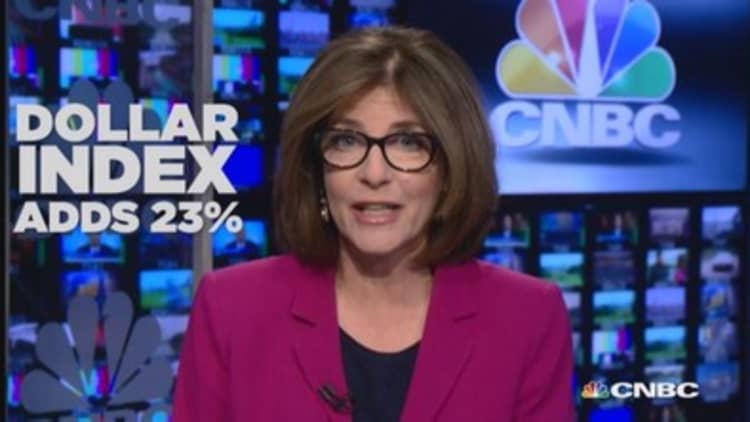
The shakeout in markets from diverging central bank policies is again a driving force for markets again Wednesday.
The fallout from central bank action sparked a dollar rally and stock market selloff Tuesday, as traders reacted to the European Central Bank's easy new bond-buying program and the fact the Fed could signal it is getting even closer to a rate hike when it meets next week.
As the dollar rose, the euro slumped to $1.07 against the greenback, edging close to parity much sooner than some strategists had expected. The S&P 500 was whipsawed, losing 1.7 percent to 2,044, in its worst selloff since Jan. 5.
U.S. stock futures were higher Wednesday, but the dollar rose and the euro continued to get slammed, trading at $1.05 to the dollar. Treasury yields were higher, even as European yields continued to move lower.
The Fed is widely expected to drop the word "patient" from its statement, and that would signal markets that it is getting closer to hiking rates as early as June.
David Ader, chief Treasury strategist at CRT Capital, said in a note Wednesday that the market is "past the first hike in psychological terms and thus, way beyond the removal of the patient language altogether."
Read MoreWill the Fed remove the word patient from the language of its next statement?
But some strategists expect the Fed's pending actions to hang over the markets.
"It certainly is European QE (quantitative easing) to a certain extent, but it's much more in my view a reaction to the Fed. In a lot of ways, we expect the weakness to continue to the 18th and what the Fed is going to say or do is fluid right now," said UBS equity strategist Julian Emanuel. "We expect the word 'patient' to be removed, but the Fed purposely gave itself a lot of flexibility. ... We may get to the 18th and quite frankly may not have that much more visibility. We continue to be cautious here."
Commodities also had a bad day Tuesday. Gold futures hit a three-month low of $1,155 an ounce, and copper futures were off 1.8 percent. Gold continued to move lower Wednesday.
West Texas Intermediate crude futures were slightly higher ahead of inventory data Wednesday, after losing 2.6 percent to $48.71 per barrel.
Read MoreWill stocks trade higher or lower ahead of the next Fed meeting?
"(Gold) topped out at $1,307 back on the 22nd of January. The key take away here is the market at this point is repositioning for some sort of hawkish tone from the Federal Reserve on March 18, and at the same time we're seeing a pretty aggressive downward trend in European yields," said Bart Melek, head of commodity strategy at TD Securities.
He said gold could test last year's low of $1,132 per ounce. "If the Fed takes out that nasty phrase—patient ... the market is going to think June is a possibility," said Melek, adding he expects a later rate hike due to weaker February economic data.
European sovereign yields helped lead the market turmoil Tuesday, with the German 10-year bund yield setting a new low of 0.226 percent. Treasury yields followed European yields lower, even though speculation about Fed rate hikes had pushed yields higher after Friday's strong February jobs report.
"There's a lot of things at play here, and it's amazing how we unwound the nonfarm payroll euphoria in just two days flat," said George Goncalves, head of rate strategy at Nomura. "I feel like people are going to be on edge around every Fed event until they pull the trigger. ... You have jitters in the stock market. We're still in a world where risk off equals lower rates. QE equals lower rates globally because there's not enough paper in the system."
Goncalves said the dollar is doing well because investors are expecting the Fed to act. The market is divided between whether the first hike is in June or September though a number of economists stressed Friday's strong report of 295,000 nonfarm payrolls does not speed up the Fed rate hike.
Emanuel said he expects the turbulence around the central bank meeting to result in a buying opportunity. "Call it prudently inpatient in the short term, but patiently waiting for what we expect to be another buying opportunity materializing, which has happened every time in the last six years," he said.
"It's just very normal for the market to be volatile at a time when you're making this transition to a different interest rate regime," he said. Emanuel said the S&P could fall toward 2,000.
Read MoreExpect 5-10% market correction, expert says
"What I've been telling people is we expect the 200-day moving average, currently around 2,001, to be challenged. How much more we go below there, if at all, is going to be a function of how people are feeling in terms of incremental clarity surrounding the FOMC next Wednesday," he said.
Emanuel said he's not worried about the Fed raising rates, when it finally does move. He looked back to the late 1970s for market behavior after rate hikes. "Once the Fed makes the first move, the average time to the market's peak is two years, and the average gain from day one is 33 percent," he said.
Read MoreDollar rally has long way to go
Besides central bank speculation, the markets will be focused on the Treasury's $21 billion, 10-year auction at 1 p.m. EDT. The Fed also releases important capital analysis information on major banks after the closing bell.
Mortgage applications data is scheduled to be released at 7 a.m. Oil inventory data will be reported by the government at 10:30 a.m. Crude could be volatile after the American Petroleum Institute reported Tuesday afternoon the first weekly drop in crude supplies in two months.
The markets will also be watching talks between Greece, the IMF, ECB and European Commission on the Greek bailout program.


